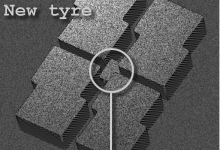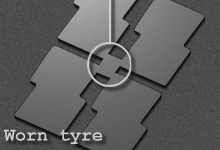Ensure your tyres
are safe and legal,
book a FREE
tyre health check
today
Tyre Fitting
When to Change a Tyre
If your car doesn't handle or grip the road as well as usual in wet weather or it takes longer to stop when you apply the brakes, this could be a sign that your tyres need changing. Because your tyres wear down gradually it can be difficult to identify these changes so we recommend that you have your tyres checked regularly by a qualified National Tyres and Autocare technician.

Tread depth indicator

This tyre is very close to being - or has just become - illegal
Advice & Guidance on Tyre Tread and UK Tyre Law
UK Tyre Law : Tyre tread and the Law
The law requires car tyres to have a minimum tread depth of 1.6mm in a continuous band around the central three quarters of the tyre. To help you judge how much tread you have on your car tyres, manufacturers often mould tread bars at roughly 1.6mm.
If you can see these bars your tyres are about to become illegal and unsafe. However, for optimum safety, most manufacturers recommend that your tyres are changed at 3mm.
Many manufacturers now include a Tread Wear Indicator (TWI) within the grooves of the tyre tread which become more visible as the tyre wears down. Whilst these markings are an indicator, always check the tread depth using a tread depth gauge and check your tyres regularly for bulges or wear.
Tyre Valves
The tyre valve is often the most neglected and overlooked component within the wheel and tyre assembly, yet an efficient valve is important for the safe operation of the tyre.
Wear on the valve seal, damaged screw threads, dirt and grit in the valve itself can lead to failure of the tyre at speed. Even a poorly sealed valve can cause fairly constant under inflation of the tyre which will reduce the life of your tyre by up to 25%. As it is impossible to replace the valve without removing the tyre casing from the wheel - National Tyres and Autocare recommend that the valves are replaced EVERY time a tyre is replaced.
Reading a Tyre Sidewall
 Every tyre sidewall shows information about the manufacturer, size, model etc. Here's a summary of the most important information and what it means.
Every tyre sidewall shows information about the manufacturer, size, model etc. Here's a summary of the most important information and what it means.
Example: 205 40 R17 84W
- 205
- means the tyre has a nominal section width of 205 millimetres
- 40
- is referred to as the aspect ratio and is the height of the tyre sidewall as a percentage of the nominal section width
- R
- means the tyre has a radial construction, the most commonly used of three different types of tyre construction: cross ply, radial and bias belted
- 17
- means it fits a 17" diameter wheel
- 84
- is the load index. This identifies the maximum load capacity of a tyre when driven at maximum speed. Overloading a tyre, by carrying more weight than it is designed to or running at a lower than specified pressure can cause heat build up and blow outs. Load indexes for passenger cars usually range from 70 - 110 and the maximum load per individual tyre is shown in the table below
- W
- is the speed rating. This represents the maximum speed that a tyre can sustain at full load. The example shown is rated for speeds up to 168mph.
| Load Index | Load (kg) | Load Index | Load (kg) | Load Index | Load (kg) | Load Index | Load (kg) |
|---|---|---|---|---|---|---|---|
| 70 | 335 | 81 | 462 | 92 | 630 | 103 | 875 |
| 71 | 345 | 82 | 475 | 93 | 650 | 104 | 900 |
| 72 | 355 | 83 | 487 | 94 | 670 | 105 | 925 |
| 73 | 365 | 84 | 500 | 95 | 690 | 106 | 950 |
| 74 | 375 | 85 | 515 | 96 | 710 | 107 | 975 |
| 75 | 387 | 86 | 530 | 97 | 730 | 108 | 1000 |
| 76 | 400 | 87 | 545 | 98 | 750 | 109 | 1030 |
| 77 | 412 | 88 | 560 | 99 | 775 | 110 | 1060 |
| 78 | 425 | 89 | 580 | 100 | 800 | ||
| 79 | 437 | 90 | 600 | 101 | 825 | ||
| 80 | 450 | 91 | 615 | 102 | 850 |
Common speed ratings are
- Q
- for cars with max speeds up to 100mph (160km/h)
- R
- for cars with max speeds up to 105mph (170km/h)
- S
- for cars with max speeds up to 113mph (180km/h)
- T
- for cars with max speeds up to 118mph (190km/h)
- H
- for cars with max speeds up to 130mph (210km/h)
- V
- for cars with max speeds up to 150mph (240km/h)
- Z
- for cars with speeds over 150mph (240km/h)
- W
- for cars with max speeds up to 168mph (270km/h)
- Y
- for cars with max speeds up to 186mph (300km/h)
You should always replace a car tyre with the same or a higher speed rating and we recommend that you check against the speed rating approved by the vehicle manufacturer.
How to check tyre tread depth
An easy way to check tyre tread depth is by using a 20p coin. Place the coin into the tyre groove, and if the border on the coin is covered, you have sufficient tyre tread. If you can see the outer edge of the coin, then your tyres are close or below the legal limit, and will need replacing soon.
If your tyres are fitted with tread wear indicators, you will be able to see these if your tread depth is low. We offer a FREE tyre check at National, in which we will check your tyre tread levels. To book, simply click the link below.
Free Tyre Check
Should tyres be changed at 3mm depth remaining?
Many vehicles and tyre manufacturers recommend changing your tyres once the tread depth is below 3mm. This is due to a major decrease in traction and performance, once the tread is below 3mm. In order to maintain performance and safety, tyres should be changed shortly after dropping below 3mm, and definitely below 2mm.
What is the minimum tread depth for summer tyres?
You should look at having your summer tyres replaced once the tread depth drops below 3mm. Tread levels above 3mm will provide optimal grip in dry, summer conditions. This will allow you to get maximum traction and performance from your summer tyres. Summer tyres should not have tread depth below 2mm, as this will significantly reduce the amount of grip when driving.
What is the minimum tread depth for winter tyres?
When using winter tyres, you will need sufficient tread depth in order to prevent the tyres from being clogged up. Therefore, a tread depth of at least 4mm should prevent any snow or ice from clogging the tyre grooves. When the tread depth drops below 4mm, you should look at having your winter tyres checked and potentially changed. This will help maintain high levels of grip when driving in tricky winter conditions.


 Sign up for SPECIAL OFFERS
Sign up for SPECIAL OFFERS
